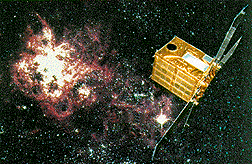

 | |
| Names | Astro-C before launch |
|---|---|
| Mission type | X-ray Astronomy |
| Operator | Institute of Space and Astronautical Science University of Tokyo |
| COSPAR ID | 1987-012A |
| SATCAT no. | 17480 |
| Spacecraft properties | |
| Launch mass | 400 kg (880 lb) |
| Start of mission | |
| Launch date | 06:28:00, February 5, 1987 (UTC) (1987-02-05T06:28:00Z) |
| Rocket | M-3S2, mission M-3S2-3 |
| Launch site | Uchinoura Space Center |
| End of mission | |
| Decay date | November 1, 1991 (1991-11-01) |
| Orbital parameters | |
| Reference system | Geocentric |
| Eccentricity | 0.01365 |
| Perigee altitude | 517 km (321 mi) |
| Apogee altitude | 708 km (440 mi) |
| Inclination | 31.1° |
| Period | 97 min |
| Epoch | February 5, 1987 |
ASTRO-C, renamed Ginga (Japanese for 'galaxy'), was an X-ray astronomy satellite launched from the Kagoshima Space Center on 5 February 1987 using M-3SII launch vehicle. The primary instrument for observations was the Large Area Counter (LAC). Ginga was the third Japanese X-ray astronomy mission, following Hakucho and Tenma (also Hinotori satellite - which preceded Ginga - had X-ray sensors, but it can be seen as a heliophysics rather than X-ray astronomy mission). Ginga reentered the Earth's atmosphere on 1 November 1991.
|
| |||||||||||||
|---|---|---|---|---|---|---|---|---|---|---|---|---|---|
| Operating |
| ||||||||||||
| Planned |
| ||||||||||||
| Proposed |
| ||||||||||||
| Retired |
| ||||||||||||
| Hibernating (Mission completed) |
| ||||||||||||
| Lost/Failed |
| ||||||||||||
| Cancelled |
| ||||||||||||
| Related |
| ||||||||||||
| |||||||||||||
|
| |||||||||||||||||||||
|---|---|---|---|---|---|---|---|---|---|---|---|---|---|---|---|---|---|---|---|---|---|
| |||||||||||||||||||||
| |||||||||||||||||||||
| |||||||||||||||||||||
| |||||||||||||||||||||
| |||||||||||||||||||||
| |||||||||||||||||||||
| |||||||||||||||||||||
| |||||||||||||||||||||
| |||||||||||||||||||||
| |||||||||||||||||||||
|
| |
|---|---|
| January |
|
| February |
|
| March |
|
| April |
|
| May |
|
| June |
|
| July |
|
| August |
|
| September |
|
| October |
|
| November |
|
| December |
|
Launches are separated by dots ( • ), payloads by commas ( , ), multiple names for the same satellite by slashes ( / ). | |
| International |
|
|---|---|
| National |
|
This article about one or more spacecraft of Japan is a stub. You can help Wikipedia by expanding it. |
This article about a specific observatory, telescope or astronomical instrument is a stub. You can help Wikipedia by expanding it. |